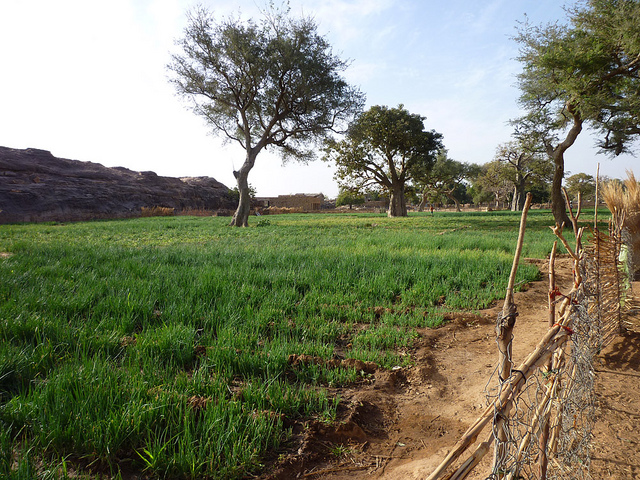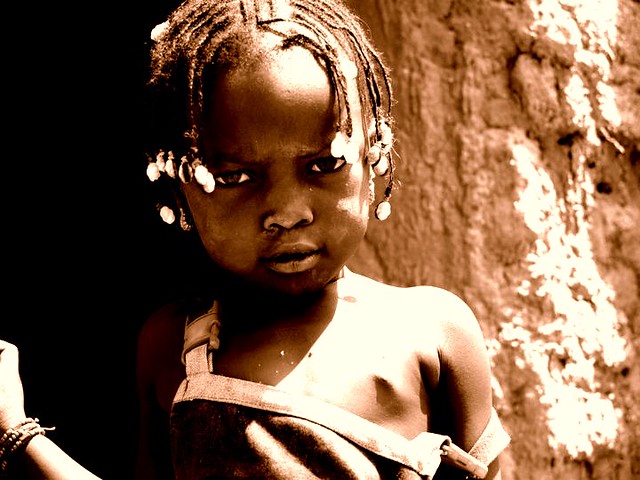In 2010, I walked in parts of Mali where now the threat of violence dogs people’s daily lives. I loved every place I visited, but it was the mystique, peace and beauty of the portion known as Dogon Country that touched me most. It is a remote region near the middle of Mali, which itself lies landlocked at the heart of the hump we call West Africa.
A sandstone cliff — 200 kilometres long and up to 500 metres high — divides the Dogon territory in two. Some of the Dogon people live atop it in the Bandiagara Highlands while others live on the Séno-Gondo Plain down below, or in villages that huddle in a line at the base of the cliff itself. My walk between these distinct worlds started in Sangha, a highland commune of mud buildings and massive baobab trees like this one. Even strong men look weak in their company.
In the wilderness beyond Sangha stood a trio of elders who provide people with advice about problems or changes in their lives. To do this they seek the help of a sacred desert creature — the pale fox (Vulpes pallida). First the men use a stick to scribble symbols in the sand to represent a client’s questions and possible answers. Then they scatter peanuts over the marks they have left and go home for the night. After the sun sets, there is a good chance that a fox will come to eat the nuts. The next morning, the elders check which answers the fox has left its footprints on — and that is the advice they give.
In the village after Sangha — a small place called Bongo — the air was ripe with the sweet scent of onions that grew in green fields all around. They became a cash crop in the Dogon Country in the 1930s when French colonists created a demand for them. When the onions are full grown their farmers pound them into a paste, which they then roll into balls to dry in the sun. In the past these fragrant spheres served as currency. Today they sell in distant markets and are a vital source of income in this poor corner of a poor country.
After Bongo — where children had filled the air with songs — the landscape became a place of peace. The silence was stunning. Even birds seemed shy. Yet more than 120 species of them live here. The plateau is also home to over 300 plant species, many of which are hard to find these days in less remote parts of Mali.
To reach the Dogon villages on the plain, I clambered over rocks along an ancient path that hugged the face of the cliff. That’s Burkina Faso in the distance across the plain.
The Dogon people migrated to this area in the 1400s from their homeland far to the South-West. When they arrived they found another group of people called the Tellem living in caves on the cliff. Little is known about these “little red people” and it is not clear whether the Dogon killed them, chased them off or assimilated them into their own society. According to Dogon oral history, the Tellem people could fly, and that’s how they built structures like these high in the cliff face to store grain and house their dead ancestors.
The picture below shows a Dogon village that sits at the base of the cliff, beneath the older Tellem structures on the cliff face. The Dogon people migrated to this place because they didn’t want to convert to Islam. When France colonised Mali, the Dogon people again hid and resisted change (apart from adopting onions, that is). Their animist culture survives in part thanks to the remote landscape they chose to call home.
Three years ago when I walked in Mali I felt only safety. Today it is a place where danger lurks. Cowards with guns threaten good people for making music, sending girls to school or simply believing in another god. The old men and the pale foxes may not have foretold this but the Dogon have seen it all before.









Beautiful story, beautiful pictures. What a privilege that you could see such amazing scenaries and thanks a lot for sharing them with us.
I also walked these hills during a trip to Mali and loved the stories that surrounded the place. I imagined the Tellem people living in the cliffs and bigger game roaming the plains below. I’m glad this blog reminds us of the beauty of the places and people in the country, and moves us beyond conflict-ridden headlines.
I have also been to those areas – in March 2011. I’ve uploaded a few pictures on my flickr page

I am fascinated by the Dogon tribe. I was recently reading about the healing powers of the Baobab tree. A great write-up with beautiful images. Many thanks Mike!
Reblogged this on Ian Bach.
I used magic 8 ball but fortune-telling foxes is something new for me ^_^